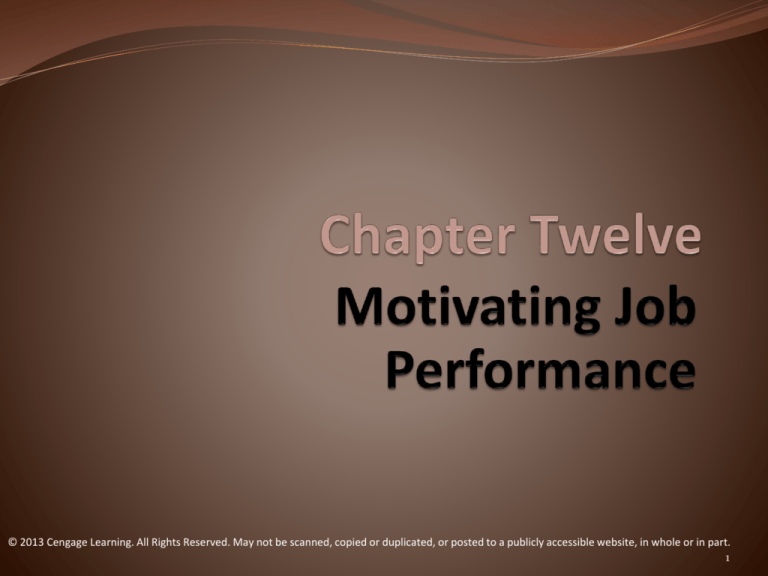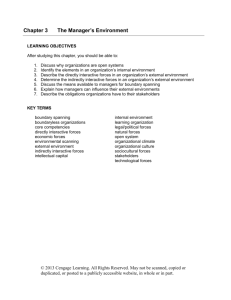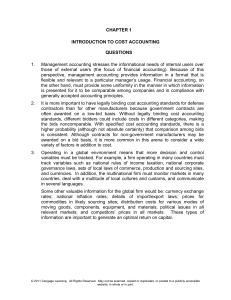
© 2013 Cengage Learning. All Rights Reserved. May not be scanned, copied or duplicated, or posted to a publicly accessible website, in whole or in part.
1
Chapter Objectives
Explain the motivational lessons taught by Maslow’s theory, Herzberg’s theory,
and expectancy theory.
Describe how goal setting motivates performance.
Discuss how managers can improve the motivation of personnel who perform
routine tasks.
Explain how job enrichment can be used to enhance the motivating potential
of jobs.
Distinguish extrinsic rewards from intrinsic rewards and list four rules for
administering extrinsic rewards effectively.
Explain how employee engagement and retention programs, open-book
management, and self-managed teams promote employee participation.
Explain how companies are striving to motivate today’s diverse workforce with
quality-of-work-life programs.
© 2013 Cengage Learning. All Rights Reserved. May not be scanned, copied or duplicated, or posted to a publicly accessible website, in whole or in part.
2
Motivation Theories
Motivation
The psychological process that gives behavior purpose
and direction
Theories of Motivation
Maslow’s hierarchy of needs theory
Herzberg’s two-factor theory
Expectancy theory
Goal-setting theory
© 2013 Cengage Learning. All Rights Reserved. May not be scanned, copied or duplicated, or posted to a publicly accessible website, in whole or in part.
3
Figure 12.2: Maslow’s
Hierarchy of Needs Theory
© 2013 Cengage Learning. All Rights Reserved. May not be scanned, copied or duplicated, or posted to a publicly accessible website, in whole or in part.
4
Self-Actualizing Manager
Characteristics of the Self-Actualizing Manager
Has warmth, closeness, and sympathy
Recognizes and shares negative information and feelings
Exhibits trust, openness, and candor
Does not achieve goals by power, deception, or manipulation
Does not project own feelings, motivations, or blame onto
others
Does not limit horizons; uses and develops body, mind, and
senses
Is not rationalistic; can think in unconventional ways
Is not conforming; regulates behavior from within
© 2013 Cengage Learning. All Rights Reserved. May not be scanned, copied or duplicated, or posted to a publicly accessible website, in whole or in part.
5
Relevance of
Maslow’s Theory for Managers
Beyond physical and safety needs, managers cannot
predict which of the three highest needs will emerge.
A fulfilled need does not motivate an individual.
Effective managers can anticipate emerging needs
based on individual need profiles and provide
opportunities for fulfillment.
The esteem level of needs satisfied by jobs and
recognition provides managers with the greatest
opportunity to motivate better performance.
© 2013 Cengage Learning. All Rights Reserved. May not be scanned, copied or duplicated, or posted to a publicly accessible website, in whole or in part.
6
Herzberg’s Two-Factor Theory
Herzberg’s two-factor theory is a theory of motivation
based on job satisfaction.
A satisfied employee is motivated from within to work
harder.
A dissatisfied worker is not self-motivated to work.
Conclusion: Enriched jobs are the key to selfmotivation.
Dissatisfiers: Factors associated with the job context or
work environment
Satisfiers: Factors associated with the nature of the
task itself (job content)
© 2013 Cengage Learning. All Rights Reserved. May not be scanned, copied or duplicated, or posted to a publicly accessible website, in whole or in part.
7
Implications of Herzberg’s Theory
Satisfaction is not the opposite of dissatisfaction.
There is a need to think carefully about what motivates
employees.
Meaningful, interesting, and challenging (enriched)
work is needed to satisfy and motivate employees.
Problems with Theory
Assumption of job performance improving with
satisfaction is weakly, at best, supported.
One person’s dissatisfier is another person’s satisfier.
© 2013 Cengage Learning. All Rights Reserved. May not be scanned, copied or duplicated, or posted to a publicly accessible website, in whole or in part.
8
Expectancy Theory (Vroom)
Vroom’s theory is a model that assumes that
motivational strength is determined by the perceived
probabilities of success.
Expectancy: One’s subjective belief or expectation that
one thing will lead to another
A Basic Expectancy Model
One’s motivational strength increases as one’s
perceived effort-performance and performance-reward
probabilities increase the likelihood of obtaining a
valued reward.
© 2013 Cengage Learning. All Rights Reserved. May not be scanned, copied or duplicated, or posted to a publicly accessible website, in whole or in part.
9
Relevance of Expectancy
Theory to Managers
Employee expectations can be influenced by
managerial actions and organizational experience.
Training increases employee confidence in their efforts
to perform.
Listening provides managers with insights into
employees’ perceived performance-reward
probabilities.
© 2013 Cengage Learning. All Rights Reserved. May not be scanned, copied or duplicated, or posted to a publicly accessible website, in whole or in part.
10
Figure 12.4: A Model of
How Goals Can Improve Performance
© 2013 Cengage Learning. All Rights Reserved. May not be scanned, copied or duplicated, or posted to a publicly accessible website, in whole or in part.
11
Goal-Setting Theory
(cont’d)
Personal Ownership and Effective Goals:
Specificity makes goals measurable
Difficulty makes goals challenging
Participation gives personal ownership of the goal
How Do Goals Actually Motivate?
Exercises in selective perception
Encourage effort to achieve something specific
Encourage persistent effort
Foster creation of strategies and action plans
Practical Implications of Goal-Setting Theory
The developed ability to effectively set goals can be
transferred readily to any performance environment.
© 2013 Cengage Learning. All Rights Reserved. May not be scanned, copied or duplicated, or posted to a publicly accessible website, in whole or in part.
12
Motivation Through Job Design
Job Design
Strategy One: Fitting People to Jobs
Strategy Two: Fitting Jobs to People
Five Core Dimensions of Work
Skill variety
Task identity
Task significance
Autonomy
Job feedback
© 2013 Cengage Learning. All Rights Reserved. May not be scanned, copied or duplicated, or posted to a publicly accessible website, in whole or in part.
13
Motivation Through Rewards
Rewards
Extrinsic Rewards
Intrinsic Rewards
Employee Compensation
© 2013 Cengage Learning. All Rights Reserved. May not be scanned, copied or duplicated, or posted to a publicly accessible website, in whole or in part.
14
Motivation Through
Employee Participation
Empowering employees to assume greater control
of the workplace
Three approaches to participation
Open book management
Self-managed teams
© 2013 Cengage Learning. All Rights Reserved. May not be scanned, copied or duplicated, or posted to a publicly accessible website, in whole or in part.
15
Figure 12.7: The Four STEP
Approach to Open-Book Management
© 2013 Cengage Learning. All Rights Reserved. May not be scanned, copied or duplicated, or posted to a publicly accessible website, in whole or in part.
16
Keys to Successful
Employee Participation Programs
Building Employee Support for Participation
A profit-sharing or gain-sharing plan
A long-term employment relationship with good job
security
A concerted effort to build and maintain group
cohesiveness
Protection of the individual employee’s rights
© 2013 Cengage Learning. All Rights Reserved. May not be scanned, copied or duplicated, or posted to a publicly accessible website, in whole or in part.
17
Motivation Through Quality-ofWork-Life Programs
Flexible Work Schedules
Family Support Services
Family-Friendly Benefits
Wellness Programs
Sabbaticals
© 2013 Cengage Learning. All Rights Reserved. May not be scanned, copied or duplicated, or posted to a publicly accessible website, in whole or in part.
18
Summary
Maslow’s hierarchy of needs contends that people are motivated by emerging rather
than fulfilled needs. Herzberg believes that the key to true satisfaction is an
enriched job. Expectancy theory argues that motivation is the product of perceived
probabilities of acquiring personally valued rewards.
Goals can be an effective motivational tool when they are specific, difficult,
participatively set, and accompanied by feedback on performance.
Managers can counteract the boredom associated with routine-task jobs through
realistic job previews, job rotation, and limited exposure.
Job enrichment helps to meet individual needs for meaningfulness, responsibility,
and knowledge of results.
Both extrinsic and intrinsic rewards can have a positive impact on performance and
satisfaction.
Participative management programs foster direct employee involvement in one or
more of the following areas: goal setting, decision making, problem solving, and
change implementation.
Quality-of-work-life programs are being used to accommodate and motivate today’s
diverse workforce.
© 2013 Cengage Learning. All Rights Reserved. May not be scanned, copied or duplicated, or posted to a publicly accessible website, in whole or in part.
19
Terms to Understand
Motivation
Rewards
Expectancy theory
Extrinsic rewards
Expectancy
Intrinsic rewards
Goal setting
Cafeteria compensation
Job design
Participative management
Realistic job previews
Open-book management
Job rotation
Self-managed teams
Contingent time off
Flextime
Job enlargement
PTO Bank
Job enrichment
Family-friendly companies
© 2013 Cengage Learning. All Rights Reserved. May not be scanned, copied or duplicated, or posted to a publicly accessible website, in whole or in part.
20









